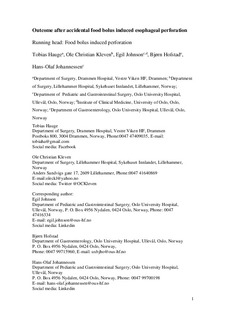| dc.contributor.author | Hauge, Tobias | |
| dc.contributor.author | Kleven, Ole Christian | |
| dc.contributor.author | Johnson, Egil | |
| dc.contributor.author | Hofstad, Bjørn | |
| dc.contributor.author | Johannessen, Hans Olaf | |
| dc.coverage.spatial | Norway | nb_NO |
| dc.date.accessioned | 2019-12-20T14:15:00Z | |
| dc.date.available | 2019-12-20T14:15:00Z | |
| dc.date.created | 2018-10-11T11:22:14Z | |
| dc.date.issued | 2018 | |
| dc.identifier.citation | Scandinavian Journal of Gastroenterology. 2018, 53 (8), 905-909. | nb_NO |
| dc.identifier.issn | 0036-5521 | |
| dc.identifier.uri | http://hdl.handle.net/11250/2634338 | |
| dc.description.abstract | OBJECTIVES:
Food bolus-induced esophageal perforation is much more seldom than iatrogenic and emetic esophageal rupture. We present results from a non-operative treatment approach as well as long-term functional outcome.
MATERIALS AND METHODS:
Medical records of 10 consecutive patients with food bolus-induced esophageal perforation from October 2007 to May 2015 were retrospectively registered in a database. Six patients developed perforation related to endoscopic removal of impacted food, and four during esophageal passage of bone, meat or bread. Treatment was sealing the perforation by stenting (n = 7) with (n = 4) or without (n = 3) chest tube drainage, chest tube drainage (n = 1), observation (n = 1) and gastroesophageal resection (n = 1) because of concomitant emesis of gastric effluent. After median 51 months nine patients reported about dysphagia, fatigue and health-related quality of life.
RESULTS:
Ten patients aged median 62.5 years (range 30-85) stayed in our hospital for 12 days (5-68 days). There was no treatment-related mortality. Nine patients were alive 63 months (18-126) after perforation. Five needed restenting (leakage, migration, impacted stent), two had drainage of a mediastinal abscess, one patient developed a transient esophagobronchial fistula. Dysphagia score was 0 (0-1). One patient developed dysphagia for some solid food. Scores for fatigue and HRQoL was similar to a Norwegian reference population.
CONCLUSION:
Treatment mainly with a non-operative approach occurred without mortality. Complications were handled by restenting and abscess drainage. Functional result for dysphagia was excellent. Interesting results on fatigue and HRQoL must be interpreted with caution because of a limited patient material. | nb_NO |
| dc.language.iso | eng | nb_NO |
| dc.publisher | Taylor and Francis | nb_NO |
| dc.rights | Navngivelse-Ikkekommersiell-DelPåSammeVilkår 4.0 Internasjonal | * |
| dc.rights.uri | http://creativecommons.org/licenses/by-nc-sa/4.0/deed.no | * |
| dc.subject | Food bolus, perforation, stenting, drainage, dysphagia, fatigue, quality of life | nb_NO |
| dc.title | Outcome after accidental food bolus-induced esophageal perforation | nb_NO |
| dc.title.alternative | Outcome after accidental food bolus-induced esophageal perforation | nb_NO |
| dc.type | Journal article | nb_NO |
| dc.type | Peer reviewed | nb_NO |
| dc.description.version | acceptedVersion | nb_NO |
| dc.rights.holder | Taylor and Francis | nb_NO |
| dc.source.pagenumber | 905-909 | nb_NO |
| dc.source.volume | 53 | nb_NO |
| dc.source.journal | Scandinavian Journal of Gastroenterology | nb_NO |
| dc.source.issue | 8 | nb_NO |
| dc.identifier.doi | 10.1080/00365521.2018.1495760 | |
| dc.identifier.cristin | 1619605 | |
| cristin.unitcode | 1991,6,8,0 | |
| cristin.unitname | Avd Kirurgi | |
| cristin.ispublished | true | |
| cristin.fulltext | postprint | |
| cristin.qualitycode | 1 | |

